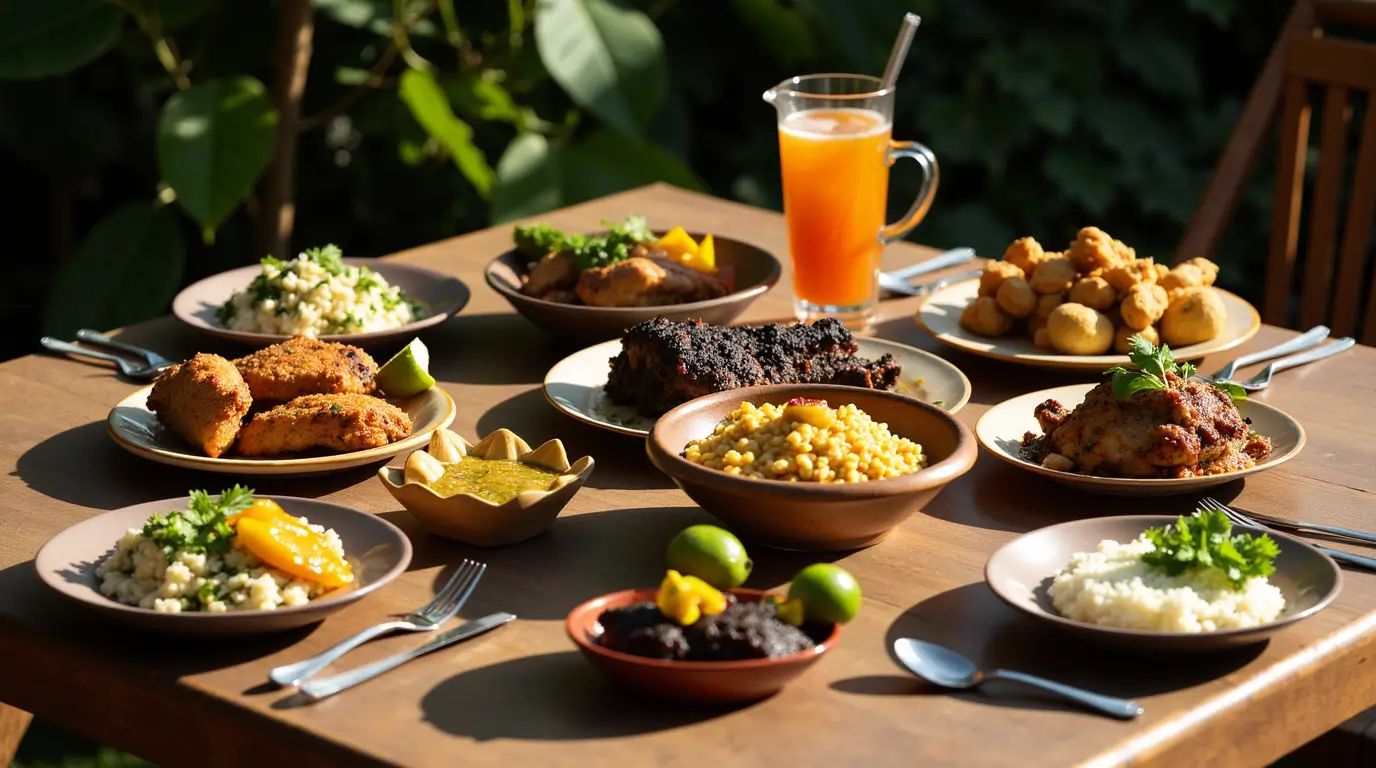Table of Contents
Table of Contents
Introduction
Jamaican cuisine is renowned worldwide for its vibrant flavors, diverse ingredients, and the rich cultural heritage that underpins every dish. While many people associate Jamaican cuisine with jerk chicken and reggae music, there is so much more to discover about the culinary traditions and practices of this Caribbean nation. In this article, we will delve deep into the story behind Jamaican cuisine—its historical, cultural, and geographical influences, as well as its evolution through colonization, trade, and migration. We will journey through the key ingredients and local products that form the basis of many traditional recipes, exploring the unique ways Jamaicans combine spices, herbs, and fresh produce to create unforgettable meals.
From the buzzing local markets filled with tropical fruits to the coastal fishing towns offering the freshest catch, Jamaican cuisine is shaped by the land’s bounty and the island’s climate. Regional differences also play a significant role in how Jamaicans eat: each part of the island, whether north, south, east, or west, may have a distinct take on certain dishes, substituting different ingredients or cooking methods. Through this exploration, we will gain a deeper appreciation for the ingenuity and creativity of Jamaican cooks, both past and present.
In the modern era, Jamaican cuisine has adapted to international trends and influences without losing sight of its roots. As a result, today’s chefs often incorporate fresh, health-conscious approaches, blending local produce with techniques and flavors from abroad, all while preserving the island’s culinary identity. Whether you are an adventurous foodie or simply curious about this exceptional gastronomic tradition, this article aims to spark a newfound respect for Jamaican cuisine and inspire you to try your hand at some of the country’s most iconic dishes. Let us embark on a flavorful journey into one of the Caribbean’s most exciting and layered food cultures.
Culinary Context and History
The story of Jamaican cuisine is a tapestry woven from the threads of the island’s geography, history, and cultural intersections. Jamaica, situated in the heart of the Caribbean, has long been a significant waypoint for trade, colonization, and migration. The earliest known inhabitants were the Taíno people, an Indigenous group who cultivated cassava, sweet potatoes, and peppers, and who left behind a legacy of staple ingredients that endure in modern Jamaican cuisine. Their agricultural practices and knowledge of local plants became foundational to the island’s dietary patterns.
European colonization, particularly by the Spanish and later the British, profoundly impacted local gastronomy. When the Spanish arrived in the 15th century, they introduced livestock such as cattle, goats, and pigs. Over time, the British brought African enslaved people to work on sugar plantations, further enriching the culinary landscape. Africans contributed not only new ingredients, like okra, but also cooking techniques and flavor profiles that are still central to Jamaican cuisine. This culinary exchange developed organically, blending African methods of cooking and seasoning with the Indigenous produce of Jamaica, alongside influences from Europe.
Trade played a decisive role in shaping Jamaican cuisine. The Chinese and East Indians, who arrived as indentured laborers in the 19th century following the abolition of slavery, brought their own spices, vegetables, and cooking methods. As a result, curry-based dishes, rice preparations, and distinct spice blends gained a foothold in Jamaican households. These diverse cultural inputs intersected with the island’s microclimates—some regions are mountainous and cooler, while others are coastal and tropical. Different produce thrived in each area, leading to strong regional distinctions. For instance, the eastern parishes near Portland are famous for their jerk pits, thanks to the abundance of pimento (allspice) trees in the surrounding hills. Meanwhile, the south coast, dotted with fishing villages, boasts a strong tradition of seafood-based dishes.
Colonization and global trade also introduced sugar cane cultivation, which propelled Jamaica to the center of the rum trade. Distilleries sprung up across the island, further embedding the culture of rum into Jamaican culinary traditions—from use in savory dishes and marinades to sweet treats and festive celebrations. Over time, certain national events and pivotal historical moments—like emancipation in 1834 and independence in 1962—played a role in shaping a unified Jamaican identity, with food as an essential expression of that identity.
Regional differences remain a fascinating aspect of Jamaican cuisine today. The mountainous regions produce fresh vegetables, coffee, and spices, contributing to dishes that highlight the island’s bounty in both texture and taste. Coastal areas have an abundance of fish, shrimp, and lobster, resulting in recipes that rely on the natural flavors of the sea. Northern tourist hubs often fuse traditional recipes with global influences, creating contemporary hybrids of classic Jamaican meals. In the western parts of the island, where Rastafarian culture is especially strong, there is also an emphasis on Ital cuisine—vegetarian and vegan cooking methods that avoid salt and artificial additives. Each region, thus, retains its own culinary character, offering travelers and residents alike a remarkably varied gastronomic experience.
Together, these historical, cultural, and geographical factors have forged a rich tapestry now recognized globally as Jamaican cuisine. This multifaceted journey, from pre-colonial staples to modern fusions, has ensured that Jamaican cooking is a flavorful reflection of its people’s resilience and creativity.
Key Ingredients and Local Products
At the heart of Jamaican cuisine is a lively palette of ingredients that reflect the island’s tropical climate and multicultural heritage. Spices play a starring role, and none is more iconic than pimento—also known as allspice—a warm, aromatic berry that combines the flavors of cinnamon, clove, nutmeg, and pepper into one. It features prominently in jerk seasoning, which is the cornerstone of Jamaican cuisine’s global fame. Scotch bonnet peppers are another defining element: small yet fierce in heat, they infuse dishes with a distinctive spicy kick and an underlying fruity tang. Beyond these two, thyme, scallions (escallions in local parlance), ginger, and garlic are staples in most Jamaican kitchens.
Vegetables and fruits abound, including callaloo (a leafy green similar to spinach), okra, breadfruit, yams, cassava, and plantains. These ingredients form the basis of numerous stews, soups, and side dishes. Ackee, a bright red pod that opens to reveal soft yellow flesh, is notably the national fruit of Jamaica and is the star in the famed ackee and saltfish dish. Mangoes, papayas, bananas, and pineapples also thrive on the island, adding a natural sweetness to both sweet and savory creations.
Due to Jamaica’s geographic position, seafood is a significant staple, particularly snapper, kingfish, and lobster. Saltfish, typically cod that has been cured and dried, is ubiquitous in Jamaican cuisine thanks to centuries of trade connections with North Atlantic fishing grounds. Pork, chicken, goat, and beef are frequently used proteins, prepared in a myriad of ways, from slow-cooked curries to quick grills.
Seasonality plays an important role in shaping traditional Jamaican dishes. For instance, certain fruits like mangoes and Jamaican plums (june plums) appear in specific months, which in turn sparks the making of juices, chutneys, and pepper sauces unique to those seasons. Market shopping is a way of life for many Jamaicans, who appreciate fresh and locally sourced produce. Visitors or newcomers hoping to recreate Jamaican recipes at home can find key ingredients in Caribbean grocery stores or online specialty shops. Alternatively, farmer’s markets in areas with Caribbean communities often carry Scotch bonnet peppers, plantains, and even allspice berries. Knowing when these items are at their peak can elevate the flavor of any Jamaican dish.
In essence, Jamaican cuisine relies on the island’s fertile land, bountiful sea, and global influences to create food that is boldly spiced, hearty, and intimately tied to the rhythms of nature.
Must-Try Traditional Dishes
Ackee and Saltfish
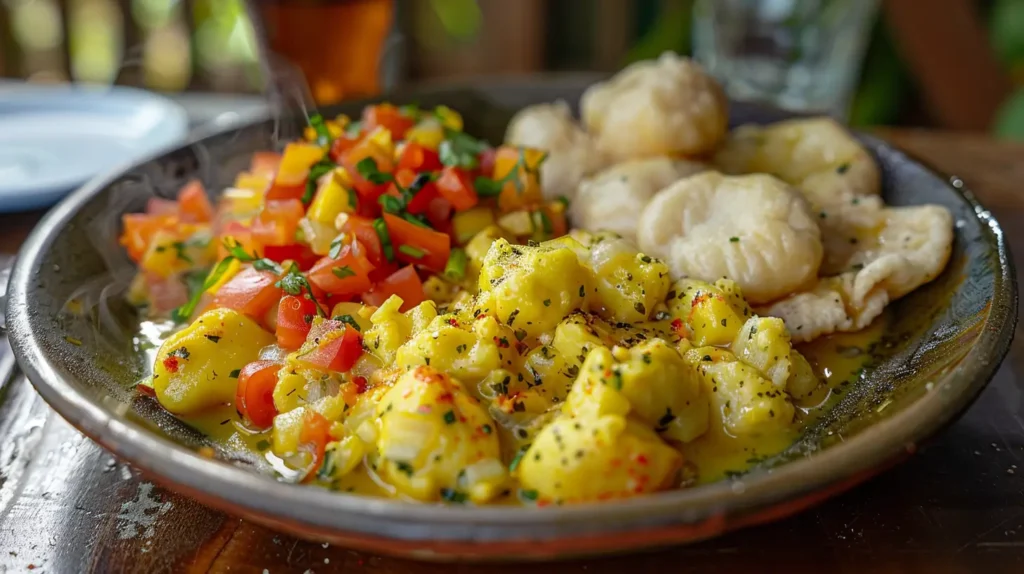
No exploration of Jamaican cuisine would be complete without mentioning ackee and saltfish, often considered the country’s national dish. Ackee is a tropical fruit that, when ripe, bursts open to reveal soft yellow arils. These arils are sautéed with salted cod, onions, tomatoes, peppers, and plenty of local spices, resulting in a dish that resembles scrambled eggs but tastes uniquely savory and rich. The history of ackee and saltfish is closely linked to the island’s colonial past and centuries of trading routes for salted fish. Today, it is typically served at breakfast or brunch, accompanied by fried dumplings or roasted breadfruit. If you want to try making it at home, be sure to purchase canned ackee if you can’t access the fresh version—just rinse and drain before cooking to remove any excess brine.
Jerk Chicken (or Pork)
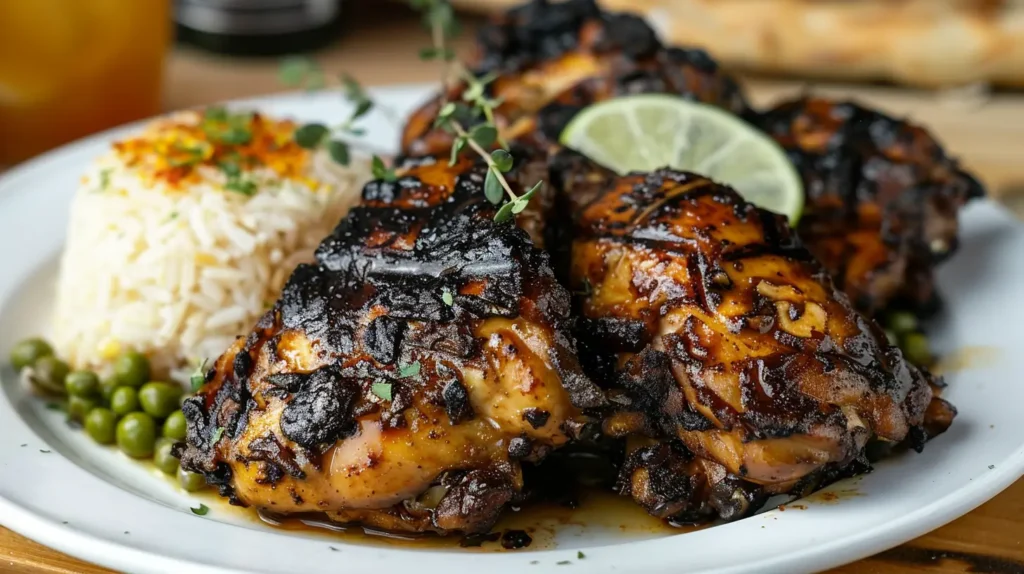
Arguably the most famous representation of Jamaican cuisine is jerk, a style of marinating and grilling meat using a spicy rub or paste made from Scotch bonnet peppers, allspice, thyme, and other ingredients. The term “jerk” is thought to come from the method of poking or jerking holes into the meat so the spices penetrate deeply. Traditional jerk is prepared over pimento wood for that signature smoky flavor, but you can achieve a respectable version at home on a grill or even in an oven by using store-bought jerk seasoning or a homemade blend of spices. The key is to marinate the meat for several hours—or overnight—for maximum flavor. Serve with festival (a slightly sweet fried dough) or hard dough bread, and you’ll have an authentic taste of Jamaican cuisine on your plate.
Curry Goat
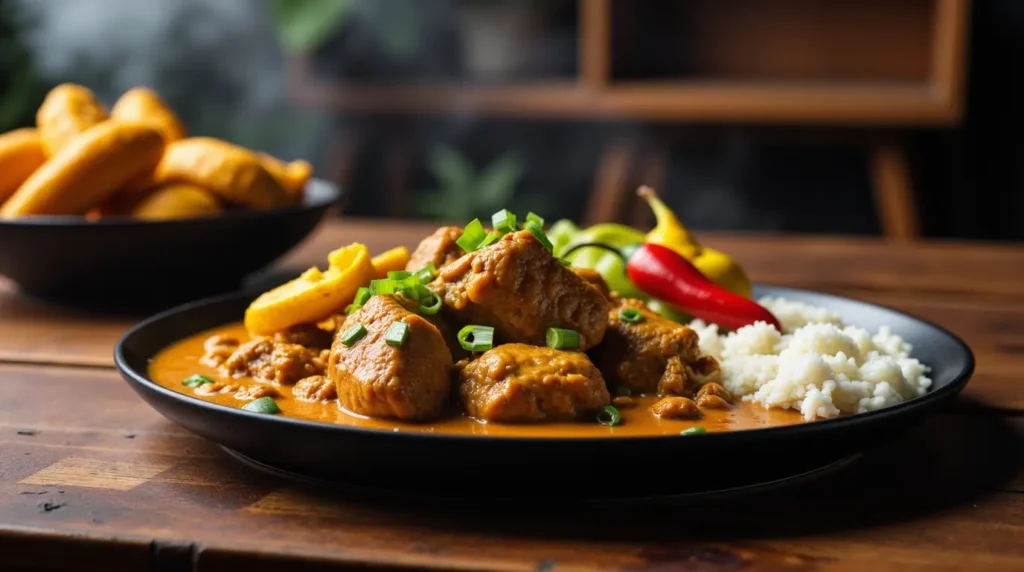
Curry goat is another quintessential Jamaican favorite, reflecting the influence of Indian indentured workers who arrived in the 19th century. Over time, Jamaicans made this dish their own by incorporating Scotch bonnet peppers, local curry powders, and distinct cooking methods that often include marinating the goat in spices and slow-cooking it until tender. The result is a hearty, comforting stew that can be enjoyed with rice and peas (rice cooked with coconut milk and red kidney beans), roti, or plain white rice. To replicate this at home, look for high-quality goat meat at a butcher or specialty grocery store, marinate overnight, and simmer until it practically melts off the bone.
Brown Stew Chicken
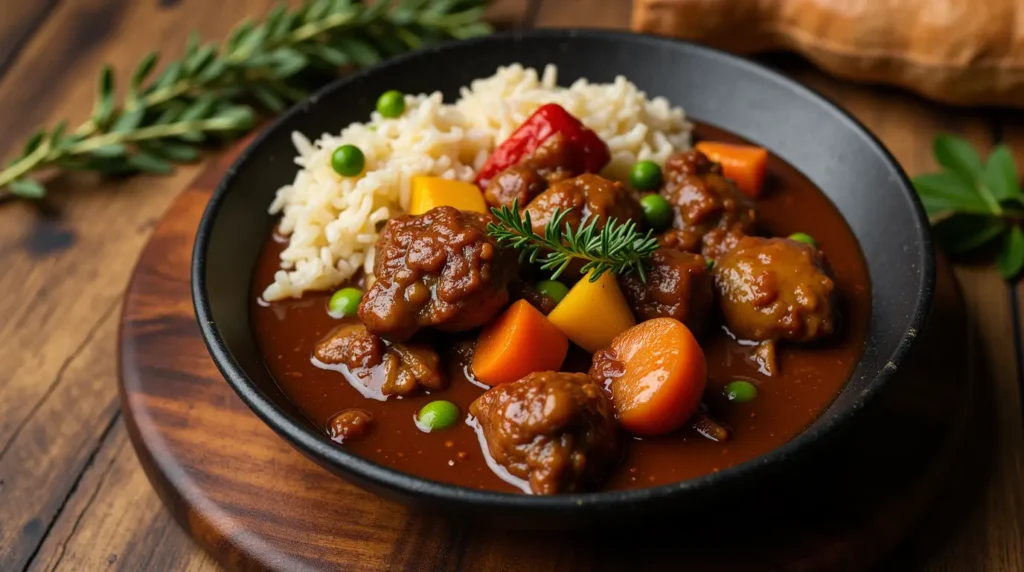
Brown stew chicken exemplifies the homey, stew-based dishes popular across Jamaica. Pieces of chicken are marinated in an assortment of spices and sauces (like browning sauce), then fried briefly to develop a deep color before being stewed in a rich gravy with vegetables. The end product is a savory meal that balances sweet, salty, and spicy elements. It pairs perfectly with rice and peas or boiled ground provisions such as yam and dumplings.
Simplified Recipe for Jerk Seasoning
- Combine in a blender: 2-3 Scotch bonnet peppers, 4 cloves garlic, 1 thumb-sized piece of ginger, 2 teaspoons dried thyme (or a small handful of fresh thyme), 1 tablespoon ground allspice, 2 tablespoons brown sugar, 1 teaspoon black pepper, 1 teaspoon salt, and a splash of soy sauce or vinegar.
- Blend until a paste forms. Adjust spice levels to taste (add more sugar if it’s too hot, or more peppers if you dare).
- Marinate your choice of meat (chicken, pork, or even tofu for a vegetarian option) with the paste and let it sit in the refrigerator for at least 2 hours or overnight.
- Grill or bake until fully cooked, basting occasionally with leftover marinade for maximum flavor.
These standout dishes are only a small sample of the depth and variety Jamaican cuisine offers. Regional variations may incorporate different spice levels, substitute available meats or vegetables, or tweak cooking methods according to local tastes and resources.
Defining Characteristics of Jamaican Cuisine
Jamaican cuisine is often described as bold, spicy, and aromatic, thanks in large part to the prevalence of Scotch bonnet peppers and allspice (pimento). This natural inclination toward strong flavors can also manifest in sweeter dishes, especially when tropical fruits like mango, pineapple, or coconut are used. Balancing heat with sweetness is a hallmark of many Jamaican recipes, resulting in a palate that appeals to those who crave complexity in every bite.
Another defining element of Jamaican cuisine is the ingenious use of herbs and spices to create layers of taste. Thyme, scallion, ginger, garlic, and pepper all converge in many recipes, working together to produce vibrant flavors rather than overshadowing the primary ingredient. The concept of marination is deeply entrenched in Jamaican cooking: whether for jerk meat, curry goat, or brown stew chicken, allowing the spices to permeate the protein for hours is key to achieving that full-bodied taste.
Beyond just the spice factor, Jamaican cuisine is inherently communal and family-oriented. Large pots of stew or curry are designed to feed multiple people, and the warm, hospitable spirit of Jamaican culture is reflected in the generous portions and heartiness of each dish. Food enthusiasts looking for new flavors will discover a cuisine rooted in fusion—where African, European, Asian, and Indigenous influences coalesce into dishes that are uniquely Jamaican yet resonate with the universal love for well-seasoned, comforting meals.
In essence, Jamaican cuisine’s defining characteristics—spiciness, depth of flavor, balance of sweet and savory, and a communal ethos—make it particularly appealing for people who enjoy culinary adventures. There is a sense of tradition embedded in every plate, coupled with an openness to innovation, ensuring that Jamaican cuisine remains both distinctive and dynamically evolving in the world of global gastronomy.
Tips and Highlights to Encourage People to Try This Cuisine
One of the best ways to spark interest in Jamaican cuisine is to share the stories and cultural significance behind each dish. For instance, learning that jerk seasoning has roots in the Maroon communities—descendants of Africans who escaped enslavement and lived in the mountainous regions—adds a layer of historical depth to that plate of jerk chicken. Similarly, hearing about the centuries-old trade routes that introduced saltfish to Jamaica can make an ordinary breakfast of ackee and saltfish feel like a journey through history.
Food enthusiasts are often drawn to the novelty and intensity of Jamaican flavors. The balance of Scotch bonnet heat with aromatic herbs like thyme and scallion offers a flavor profile that stands out even among other spicy cuisines. Additionally, the incorporation of tropical fruits and vegetables lends a refreshing contrast to the peppery bite of jerk and curries. By highlighting these taste combinations—spicy, sweet, and savory—you can entice adventurous eaters to explore Jamaican cuisine.
A fun tip for newcomers is to start with milder dishes and progressively work your way up to the spicier ones. For example, begin with brown stew chicken or escovitch fish (fried fish in a pickled pepper sauce), which are rich and flavorful but not overwhelmingly hot. Once you develop a taste for the seasonings, move on to jerk chicken or peppered shrimp for a bolder experience.
For those traveling to Jamaica or visiting Jamaican restaurants abroad, ask locals or staff for recommendations on what to try—often, the best culinary experiences are those that might not be on mainstream menus. Also, don’t forget to explore Jamaica’s vibrant street food scene, where you’ll find everything from spicy patties to freshly squeezed juices. These experiences can offer a more authentic glimpse into how Jamaicans enjoy their food on a daily basis.
Table Rituals and Customs
Meals in Jamaica often reflect a relaxed yet communal approach to dining, influenced by the island’s culture of warmth and hospitality. Breakfast can be hearty and filling, featuring staples like ackee and saltfish or mackerel rundown paired with fried dumplings or boiled green bananas. Lunch might include a quick patty on the go—Jamaican patties are beloved savory pastries stuffed with spiced beef, chicken, or vegetables—or a takeaway box of jerk chicken with rice and peas. Dinner, typically the largest meal of the day, may involve a variety of stews, curries, and sides shared among family or friends.
Customarily, Jamaicans take pride in serving food in generous portions, reflecting the idea that a well-fed guest is a happy one. When dining in a Jamaican home, you might notice that the host insists you try a bit of everything—this is a sign of hospitality and is considered polite. In more formal settings or when attending family gatherings, communal dishes are placed at the center of the table, allowing everyone to serve themselves. It is generally considered impolite to leave before everyone has finished their meal or to reject a dish outright.
National holidays and religious events also have specific culinary traditions. For example, Christmas in Jamaica is incomplete without sorrel (a tangy hibiscus-based drink) and Christmas cake (a rich fruit cake soaked in rum). Easter brings bun and cheese, a spiced sweet bread paired with slices of cheese. Family celebrations often center on hearty meals featuring staples of Jamaican cuisine, ensuring that food remains a bonding mechanism for loved ones.
Table etiquette is relatively straightforward: Jamaicans appreciate politeness, gratitude for the meal, and a willingness to join in the convivial spirit. Avoiding waste and showing enjoyment of the meal will always be received positively. Through these customs, we see how Jamaican cuisine is not just about the food itself but the shared rituals and gestures that bring people together around the table.
Modern Trends and Culinary Fusions
Jamaican cuisine, while deeply rooted in tradition, has continually evolved in response to external influences and new dietary considerations. In major cities like Kingston and Montego Bay, you’ll find restaurants experimenting with fusion cooking, blending Jamaican spices with techniques from Asian, European, and Latin American cuisines. Chefs may top jerk-seasoned pizzas with peppery jerk chicken or use Scotch bonnet-infused sauces to jazz up tacos and pasta. This openness to blending traditions has kept Jamaican cuisine relevant and exciting, attracting a younger generation of local and international diners.
Additionally, modern health and wellness trends have sparked a resurgence of interest in natural, organic ingredients, as well as vegetarian or vegan adaptations of classic dishes. The Rastafarian concept of Ital cooking—emphasizing fresh, natural, and unprocessed foods—has found a broader audience beyond its religious roots. Meat-free versions of staples like curry chicken, jerk, or brown stew now feature ingredients like jackfruit, tofu, or mushrooms. These dishes still draw on the same Jamaican flavors but align with ethical or health-driven diets.
A number of young chefs and restaurateurs in Jamaica are also championing the “farm-to-table” philosophy, partnering with local farmers to source produce, meats, and dairy. This approach reduces the environmental impact and guarantees fresher, higher-quality ingredients. By incorporating contemporary plating styles and global culinary methods, these professionals are rejuvenating Jamaican cuisine while preserving its distinctive seasoning profiles and cultural narratives.
Local food festivals and competitions further encourage innovation by showcasing both traditional and experimental Jamaican dishes. Tourists and locals alike can sample new takes on old favorites, discovering how Jamaican cuisine continues to expand its repertoire while remaining true to its core identity. In essence, modern trends serve as a testament to the adaptability and creativity inherent in Jamaican cooking—a cuisine that has always blended influences to forge something uniquely its own.
Conclusion and Call to Action
In summary, Jamaican cuisine stands out for its bold, layered flavors and the rich tapestry of cultural, historical, and geographical influences that have shaped it over centuries. From the Taíno origins of staple crops like cassava to the African techniques that introduced complex spice blends, every plate of Jamaican food tells a story. Regional distinctions—from the jerk pits of Portland to the seafood specialties of the southern coast—demonstrate the island’s culinary diversity, while modern fusions and health-conscious twists ensure that Jamaican cuisine remains as dynamic as ever.
At its core, Jamaican cuisine is an invitation to commune around a shared table, embrace new tastes, and appreciate the heritage embedded in every mouthful. Whether you’re experimenting with jerk seasoning in your home kitchen, seeking out Caribbean grocery stores for fresh Scotch bonnet peppers, or planning a visit to Jamaica itself, there are countless ways to immerse yourself in this captivating food culture. If you’ve ever tried Jamaican dishes, share your experiences or favorite recipes with friends, family, or online communities—spreading the love of Jamaican cuisine is part of keeping its traditions alive.
Should you have questions, insights, or stories about a particular dish, reach out to fellow food enthusiasts who share your passion. Jamaican cuisine is a vibrant, communal affair, and the more people who engage with it, the more it thrives. And if you’re hungry for more, stay tuned for our future article exploring the art of pairing Jamaican dishes with the perfect rum, a beverage deeply intertwined with the island’s gastronomic legacy. Until then, let the flavors of Jamaica guide you on a culinary journey that spans centuries, continents, and traditions, all fused into an experience that is distinctively and proudly Jamaican.

